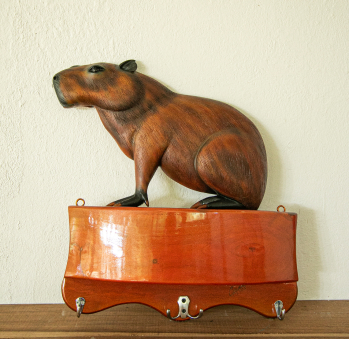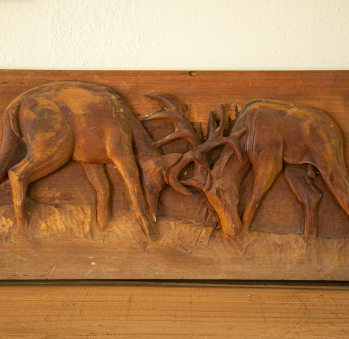José Claudio Vasquez
Workshop: Claudio Artes
Craft: Trabajo en madera
Trail: Arauca Route
Location: Saravena, Arauca
SCHEDULE YOUR VISIT
Calle 18 # 23-78, Saravena, Arauca
3133517292
jv4965262@gmail.com
At the tender age of eight, José Claudio arrived in Arauca with his family, encountering a whole new fauna, previously unseen in Zetaquira, Boyacá, their former home. Unfathomable creatures emerged from the surrounding rainforest, venturing into their house. Fear eluded them because these animals had never encountered humans. José Claudio recalls the cachicamos, or armadillos, giant anteaters, tapirs, and mapuros that preyed upon their chickens. He also fondly remembers the harmless porcupines that emerged at night from the ranches’ ceiling beams, leisurely traversed the area, and returned to their nests. José Claudio had never witnessed woodcarving, but at fifteen, an inspiration sparked within him, and he began carving using a rudimentary knife. Among the various animals he lived with, he chose owls as the starting point of his self-taught carving journey. He was surrounded by diverse owl species, recognized by sight and their distinctive calls rather than by name. Utilizing the black and white wood of the caracara tree—traditionally used for crafting canoes—he fashioned key rings with small owls, keeping a pair as a memento of his initial wooden creations.
Very little remains of the rainforest that José Claudio encountered as a child—the diverse fauna, flora, and the towering tolúas or cedro macho trees, spanning two meters in width and towering between 30 to 40 meters in height. The rainforests were felled by settlers aiming to render the land productive, transforming it with plantain, corn, pineapple, and passionfruit crops, along with cattle ranching. Presently, only memories of the centennial tolúas thriving in the fertile rainforests endure. As the trees were felled, their prized wood, valued for its quality in boat construction, was sold. José Claudio himself worked in a sawmill for many years, importing ceiba tolúa wood until he realized the disrespect and danger inherent in this work. He began viewing trees through a new lens, considering these defenseless beings undeserving of harm. Since that realization, he has been unable to cut another tree. Instead, he seeks out smaller ceibas—the descendants of ancestral trees—near the shores of rivers like Pescador, Arauca, Madrevieja, Banadia, Saravena, and Fortul. Once these trees are carried away by river overflow and swept by its currents, José Claudio collects their distinctive wood. While the younger, refined, and soft wood exhibits a wide white border and a red center, the wood from the immense trunks of their ancestors boasted a slender white border and broader red hearts.
He utilizes this wood to depict the fauna and flora of the Llanos, a domain he is intimately familiar with. His self-taught craft flourished with the tools he encountered upon leaving his childhood mountains and arriving in Saravena: the jigsaw, bandsaw, brushes, and airbrushes undoubtedly aided in crafting more intricate and delicate pieces. Moreover, it was here that he met Joaquín Caballero, a fine arts master who taught him the art of airbrush painting.
José Claudio introduces his own renditions of the animals he befriended in his childhood to youngsters unfamiliar with them. He imparts carving skills to those interested in learning, conducting courses in Fortul, Saravena, Cravo Norte, and Arauca for youths and individuals with hearing, sight, and speech impairments. This generous artisan possesses a profound understanding of the creatures he shares the Earth with. He intimately knows the songs of pavas, guacharacas, and pahuiles, just as he recognizes the calf-like calls of deer and the distinct odor of cajuches, a type of mountain pigs. Over two decades of practicing this craft have equipped him with the ability to carve local fish like ray fish, chachama, bocachico, bagre cajaro, and barge rayado. With guidance from the master artist Joaquín Caballero, he paints their distinct spots, scales, eyes, as well as each of the spines of the porcupines he encountered in the mountains as a child. He particularly relishes sculpting chiguiros, or capybaras, for their endearing faces, appreciated by his clientele. Each creation he crafts reflects José Claudio’s deep knowledge of his cherished Arauca lands. With his skilled hands and a gift for carving, he celebrates the richness of the place he calls home.
Craft


















Artisans along the way
Artisans along the way
No puede copiar contenido de esta página





























































